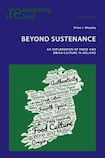
The cultural significance of food and drink beyond pure sustenance motivated the writing of this book. Its organisation reflects the idea that they can be viewed from an international or national perspective to a regional or local one, and finally on an individual product level.
Four themes are explored: how food and drink can be viewed through a cultural lens and how perceptions of them have recently changed in Ireland; how individual food-and-drink places (pub, butcher shop, distillery) reflect and contribute to Ireland’s gastronomic identity; how products from those places have developed an historical importance and identity which can influence how they’re perceived and what lessons can be learnt from that; and how more recent gastronomic developments are affecting our relationship with food and drink.
Brian Murphy’s quintessential argument is that although where food comes from matters, so too does where it’s consumed. It’s not just about flavours on the plate or liquids in the glass, but their “broader societal impact and cultural significance”. However, he also acknowledges that for much of the world’s population, getting adequate food is uppermost and cultural impacts count for little, while the climate-change challenge exacerbates this glaring problem.
The book emerged from a PhD thesis. Its subject is increasingly a part of Irish academic study and there are many references to scholarly research throughout. It would be a pity if this aspect put some readers off and the brief personal anecdotes that preface many chapters help to contextualise and make more immediate, relevant and comprehensible the ideas that are discussed. Murphy has spent most of his life working in the food and drink industry. Also very helpful in this regard are the conclusions provided by the author to each chapter.
READ MORE
Murphy discerns a newfound food confidence in Ireland, which has been achieved partly by borrowing from the gastronomic experience in other countries, especially France, but here, too, he feels things are changing as we place equal value on our own food identity.
He hopes that his book “offers a new perspective on our traditional understanding of the food-and-drink studies area”. That hope is certainly realised. He also speaks about the new researchers in the area combining practical competence with academic ambition – something he himself achieves with this publication.















